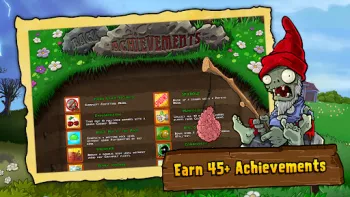Apps Home

Plants vs. Zombies™
The Genesis of Plants vs Zombies - The Survival Challenge
The inception of "Plants vs Zombies - The Survival Challenge" traces back to its roots in the burgeoning era of casual gaming where simplicity, creativity, and engagement were paramount. PopCap Games, the developers behind this iconic title, reinvented the tower defense genre by incorporating a unique blend of strategy, humor, and charm. The core idea of this game stands out; you, as the player, are tasked with protecting a garden from waves of quirky zombies. Each zombie, from the basic shambling variety to the more sophisticated snorkeling or pole-vaulting types, introduces a distinct challenge requiring strategic plant placement and resource management. The game's development process underscored a profound understanding of user experience and gameplay mechanics, ensuring accessibility to a broad audience while maintaining depth for seasoned gamers. With each zombie type requiring different strategies and each plant offering unique abilities, the subtleties of gameplay were meticulously crafted. Strategically, a player must balance immediate tactical decisions with longer-term strategic planning to ensure resource sustainability. The humor and personality infused into every element, from the almanac entries to the animations, not only create a memorable gaming experience but also set "Plants vs Zombies" apart from its contemporaries. This conceptual uniqueness, combined with a devotion to polish and balance, made "Plants vs Zombies" a beloved franchise and laid the groundwork for its Survival Challenge mode, which tests even the most adept players with nonstop waves of undead invaders.
Understanding Gameplay Mechanics in Plants vs Zombies
The gameplay mechanics of "Plants vs Zombies - The Survival Challenge" are a masterclass in combining simplicity with depth. Players are introduced to a playfield composed of a front yard dotted with grass lanes, each serving as a pathway for incoming zombies. The primary objective is clear: safeguard your home by strategically planting a variety of flora in these lanes. The challenge emerges from managing limited resources, notably sunlight, which is the currency required for planting your green arsenal. Sunflowers, one of your initial and most crucial plants, provide a steady stream of sunlight when planted, necessitating their early and strategic deployment. As the levels progress, the environmental conditions shift—players navigate through scenarios such as nighttime darkness, rooftop angles where particular plants have limitations, and pool environments which introduce new gameplay mechanics. These changes demand adaptability and foresight from the player to tailor their strategies accordingly. Each plant has unique attributes, whether it's the offensive capabilities of the peashooter, the defensive fortitude of the wall-nut, or the explosive power of the cherry bomb. The zombie adversaries themselves intensify the strategic complexity; some are armored, others are speedsters, and some even float in on balloons, requiring players to deploy specific counterplants to neutralize them effectively. This dynamic interaction between plants and zombies forms the crux of the game's strategy: understanding each plant's role, predicting zombie paths, and altering plant layouts in real-time. Players are also encouraged to utilize the in-game almanac to study both their botanical allies and undead foes, enhancing decision-making and tactical planning in successive waves.
Strategies to Master Survival Mode in Plants vs Zombies
Mastering the Survival Mode in "Plants vs Zombies - The Survival Challenge" is a journey that requires both strategic acumen and experimentation. Unlike the finite levels of Adventure Mode, Survival Mode pits players against an inexhaustible wave of zombies, challenging them to see how long their defenses can last. The key to success lies in designing an adaptable strategy that can respond to evolving threats. Initially, constructing a solid economy with sunflowers or sun-shrooms is imperative, allowing players to amass the necessary sunlight for deploying more complex strategies. Following this, establishing a baseline defense with low-cost plants like pea shooters paired with wall-nuts forms the first line of resistance to initial zombie incursion. As the game progresses, the player must weave in more advanced plants, utilizing powerful artillery such as the cherry bombs or squash to eliminate threatening zombie clusters. Balloon zombies, bobsled teams, and digger zombies are just a few of the unique challenges that arise, each demanding specialized plant preparations. Moreover, the aquatic aspect introduced by pool levels necessitates the deployment of catapults or plants like lily pads to counter submariners such as snorkelers. The game's ever-increasing difficulty hinges not just on plant deployment but also on shrewd use of resources. Accumulating coins through surviving waves enables players to purchase upgrades, which can be decisive in extending longevity. Additionally, learning to manage your plant choices and switching strategies when new circumstances arise is a must. An understanding of plant synergy—such as utilizing torchwood for boosted pea damage or employing magnet-shrooms to neutralize metallic threats—further exemplifies the advanced tactics needed to thrive and survive in this challenging mode.
The Impact of Plants vs Zombies on the Gaming Industry
"Plants vs Zombies - The Survival Challenge" has had a lasting impact on the gaming industry, exemplifying how innovative gameplay and charming design can achieve critical and commercial success. This game redefined the tower defense genre by introducing an accessible yet deep strategic experience infused with humor and personality. It demonstrated to developers the value of investing in user-friendly interfaces and gradual difficulty curves, making complex strategic gameplay accessible to a broad audience, including those new to the genre. Furthermore, Plants vs Zombies' extensive use of whimsical art and music set a standard for integrating aesthetic appeal within gameplay, providing full immersion without sacrificing challenge or depth. The standard it set helped pave the way for a wave of casual games that prioritize user engagement through a combination of challenge and lighthearted entertainment. Its humor and narrative elements proved that serious gameplay and fun are not mutually exclusive, encouraging more developers to experiment with tone and storytelling in their game designs. Commercially, its success across multiple platforms expanded the marketplace for games that could succeed equally well on PCs, consoles, and mobile devices, highlighting the growing importance of cross-platform accessibility. Beyond these innovations, the game's monetization strategies via optional in-app purchases signaled a shift in revenue models for games, a precursor to the free-to-play market explosion. By demonstrating the viability of quality gaming experiences in smaller, downloadable packages, "Plants vs Zombies" has inspired countless indie developers to pursue creative concepts that might once have seemed too niche for large-scale distribution.
How to Access Plants vs Zombies - The Survival Challenge on Various Platforms
Accessing "Plants vs Zombies - The Survival Challenge" on various platforms highlights the game's broad appeal and its adaptability across different gaming ecosystems. Each platform offers the same engaging experience, but with interface optimizations that ensure optimal gameplay regardless of device capabilities. For Android users, a simple visit to the digital store ensures that the game is just a click away, while iPhone users can embark on their zombie-slashing journey with ease thanks to its availability on Apple’s store. Windows enthusiasts can indulge in the vibrant world of plant and zombie battles directly from the official game website, enjoying the deeper graphical and control customization options afforded by the PC environment. Linux users aren't left behind—they can delve into the game's extensive lore seamlessly through a platform designed for compatibility and ease of use. Mac users can also enjoy a fluid experience with version tailored to Apple's intuitive interface, making it straightforward to download and install. This multi-platform availability not only emphasizes the game's widespread popularity but also ensures that players can engage and strategize against the apocalypse wherever they choose. Ensuring that each version maintains the critical elements of the original game has been essential, making it a trailblazer in showcasing how seamless cross-platform gaming can be achieved. Whether you're ready to defend your garden with a smartphone in hand or seated at a computer desk, the adventure awaits—all that’s needed is to decide where to plant your first sunflower. For those eager to jump in, Download for Android, Download for iPhone, Download for Windows, Download for Linux, and Download for Mac.
Share Your Opinion
Your Email Will Not Be Published.
All Rights Reserved © Apps Home 2025










































Francine Taylor
I love to kill zombies. I kill them on my computer, on my phone, on my tablet. On the bus, at a boring party, in bed at night. I've been playing pl...
Lucas Greene
Great, even in 2025. This game I have played quite often when I was younger and is pretty easy to play. It does take a minute to beat, however. Ove...
Jaxon Hodgen
I'm not an OG player, so this is a rather unbiased opinion. I do greatly enjoy this game, it's never boring and honestly the ads are bearable. One ...
Patric Finnigan
After 4 months I started playing this game again. I've only been playing every other game, and for good reason. 1. They're removing lawn mowers in ...
VioletNinja
I love this game. It's challenging at times, but still fun However, lately the app has been giving me trouble. When I'm in Zen Garden and watch an ...